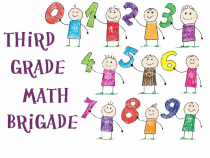Objective: I can multiply numbers 1-6.
Standard: CCSS.Math.Content.3.OA.A.1
Interpret products of whole numbers, e.g., interpret 5 × 7 as the total number
of objects in 5 groups of 7 objects each. For example, describe a context in
which a total number of objects can be expressed as 5 × 7.
Task Analysis:
Each student will be given a “Multiplication Monster” worksheet (available as a PDF under the right sidebar), which instructs them to roll two dice to determine each factor of the empty multiplication sentences listed. The product of these two numbers will tell the student how many of a certain feature their “monster” will have.
Once the student finishes rolling and solving their multiplication problems, he/she will use construction paper and coloring utensils to create the monster with the specified numbers of each body part.
Materials: Dice, “Multiplication Monster”
worksheet, construction paper, coloring utensils
Thinking Levels
Bloom’s Taxonomy:
Knowledge: The students will recall/solve
answers to multiplication problems.
Multiple Intelligences:
Visual: The students will physically write out and
view multiplication problems and their answers.
Kinesthetic: The students will roll dice and construct
their "monsters".
Logical: The students will solve multiplication problems.
Closure:
Once everyone has finished creating their “monster”, each student will show his/hers to their group and their group members will try to guess the multiplication problems that resulted in each number of body parts.
Benefits:
This activity allows students to get creative in representing the math that they’ve done. It also helps students to see multiplication as groups of tangible objects (ex: 3 groups of 6 legs, 1 group of 4 eyes, etc.). During the closure, students will think backwards to try to decide which factors multiply to a known product. This process will begin to introduce them to the concept of division.
Source:
Standard: CCSS.Math.Content.3.OA.A.1
Interpret products of whole numbers, e.g., interpret 5 × 7 as the total number
of objects in 5 groups of 7 objects each. For example, describe a context in
which a total number of objects can be expressed as 5 × 7.
Task Analysis:
Each student will be given a “Multiplication Monster” worksheet (available as a PDF under the right sidebar), which instructs them to roll two dice to determine each factor of the empty multiplication sentences listed. The product of these two numbers will tell the student how many of a certain feature their “monster” will have.
Once the student finishes rolling and solving their multiplication problems, he/she will use construction paper and coloring utensils to create the monster with the specified numbers of each body part.
Materials: Dice, “Multiplication Monster”
worksheet, construction paper, coloring utensils
Thinking Levels
Bloom’s Taxonomy:
Knowledge: The students will recall/solve
answers to multiplication problems.
Multiple Intelligences:
Visual: The students will physically write out and
view multiplication problems and their answers.
Kinesthetic: The students will roll dice and construct
their "monsters".
Logical: The students will solve multiplication problems.
Closure:
Once everyone has finished creating their “monster”, each student will show his/hers to their group and their group members will try to guess the multiplication problems that resulted in each number of body parts.
Benefits:
This activity allows students to get creative in representing the math that they’ve done. It also helps students to see multiplication as groups of tangible objects (ex: 3 groups of 6 legs, 1 group of 4 eyes, etc.). During the closure, students will think backwards to try to decide which factors multiply to a known product. This process will begin to introduce them to the concept of division.
Source:


